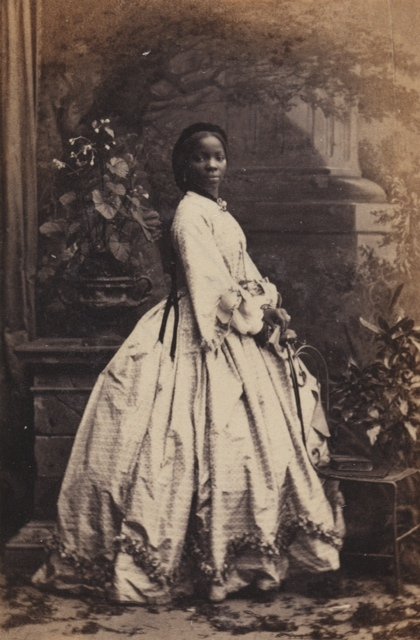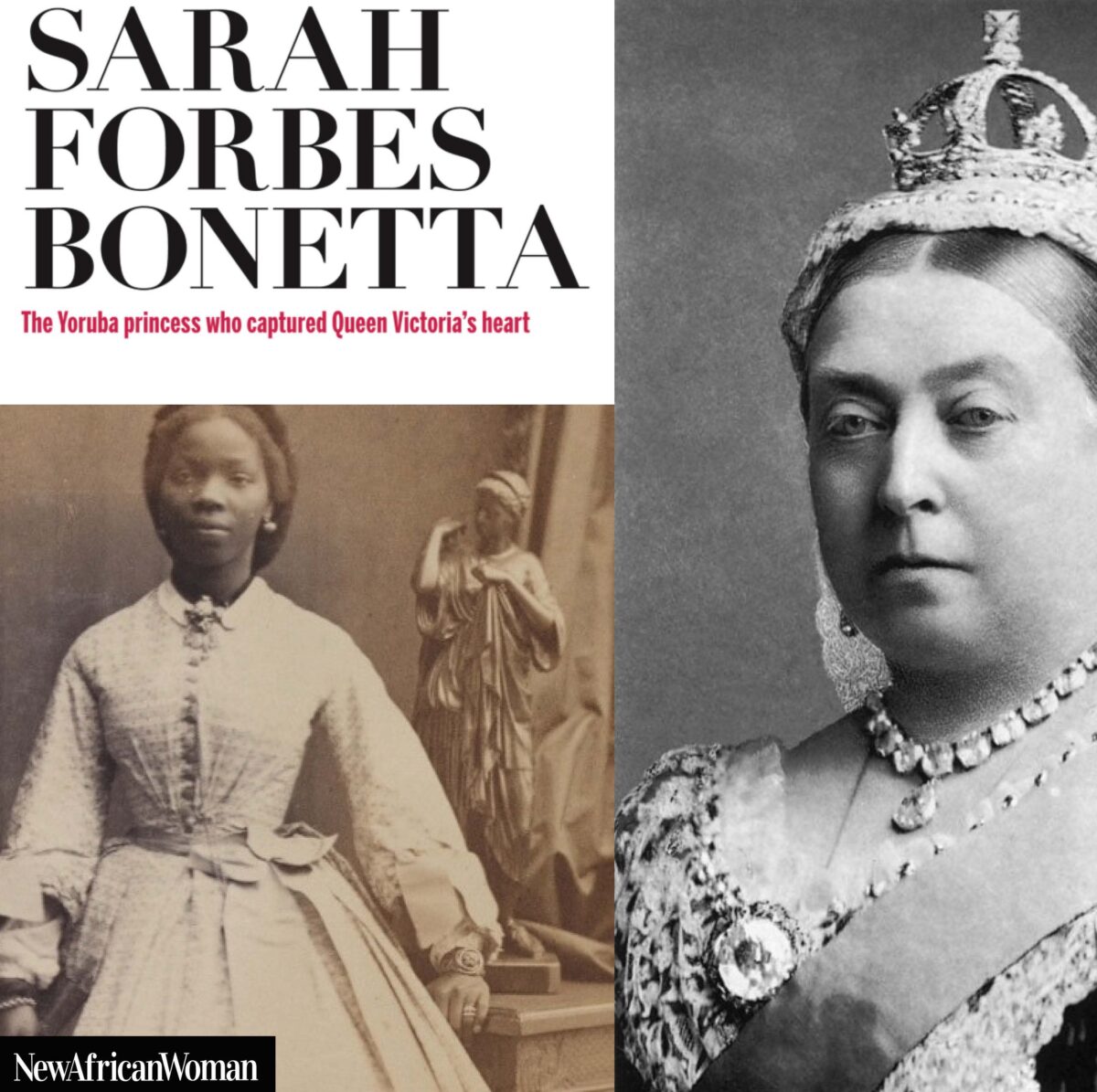HISTORY: SARAH FORBES BONETTA – The Yoruba Princess who captured Queen Victoria’s heart

Contributor
It is only very recently that Sarah Forbes Bonetta’s beautiful, yet tragic story has begun to attract the attention it deserves. It is a bittersweet tale of extremes and one that uncovers the complex, colonial narrative around race, class and gender in Victorian England. Meet the Yoruba princess who to this day still mesmerises followers of British royal history and colonialism. By Kemi Bamgbose
A striking, dark-skinned African woman dressed in a beautiful gown gazes at the camera. She is young, just shy of her 20th birthday. Her naturally regal presence, reflecting that of a young aristocrat, is evident to all who observe her. It is one of several photographs of this woman, including a few with her husband; both are clearly wealthy.
It is Victorian England and a rather unusual sight – black people were present but rarely seen in this way. The photos are special because they were taken on the wedding day of Sarah Forbes Bonetta, the young woman widely known as British Queen Victoria’s black godchild, who was in fact, royalty in her own right.
Sarah Forbes Bonetta’s (or Lady Sarah’s) life began in South-western Nigeria. She was born into a royal household in 1843 in Oke-Odan, an Egbado village. Her original name was Aina, a Yoruba name given to a girl child born with an umbilical cord around its neck.
In 1848, her village was attacked by the army of Dahomey (from present-day Benin), during which her family were murdered.
Aina was an Egbado princess – Egbado Omoba – the tribal marks on her face revealed her royal heritage, and also the reason why her life was to be temporarily spared.
Aina was captured and imprisoned for two years before being dramatically rescued by Royal Navy Commander Fredrick Forbes in negotiations with the formidable King Ghezo whose army had been responsible for the death of Aina’s family. Aina was to be given, it was documented, as a “gift from the king of the blacks to the queen of the whites – Queen Victoria.”
Aina was renamed by Commander Forbes after the ship HMSBonetta (which transported her to British shores) and taking his surname. Despite being barely five or six years old, Sarah had already experienced great tragedy and trauma. Thankfully, her fortunes were soon to change.
Sarah Forbes Bonetta’s (or Lady Sarah’s) life began in South-western Nigeria. She was born into a royal household in 1843 in Oke-Odan, an Egbado village. Her original name was Aina, a Yoruba name given to a girl child born with an umbilical cord around its neck.
Given the socio-historical context and the cultural expectations of the time, Sarah could have hoped to have received only a basic standard of living. However Queen Victoria, who was personally opposed to racism (potentially ironic given the nature of the British Empire), was fond of Sarah and paid for her education and upbringing throughout her lifetime. In fact the Queen recognised that Sarah was royal, calling her a princess, an unexpectedly enlightened admission by one of the world’s most powerful monarchs.
Sarah was a highly intelligent child who learnt English quickly and showed a particular talent for music and the arts. She lived with the Forbes family, but after the untimely death of Commander Forbes was sent to live with the Schoen family in Kent.
During this time, Sarah made several royal visits to see Queen Victoria. In Walter Dean Myers’ book, At Her Majesty’s Request: An African Princess in Royal England, there are letters documenting her visits, the preparation required, the assumed etiquette when in the Queen’s presence, such as what to say and how to behave, providing great insight into life in upper-class Victorian England.
There are also snippets of Sarah’s interactions with the royal children, including Princess Alice, whose wedding she would attend years later.
In 1851 Sarah developed a persistent cough and was sent back to West Africa based on the best contemporary medical advice; it was assumed the warmer climate would be more suitable. Sarah attended the Female Institution in Freetown, Sierra Leone – a Church Missionary Society school where she was given preferential treatment. During this time she received regular correspondence from Mrs Forbes and gifts from the Queen.
One of her fellow pupils was Abigail Crowther, daughter of the famous first African Anglican Bishop of Nigeria, Samuel Ajayi Crowther. Sarah excelled academically, much to the Queen’s pleasure.
Sarah was thought to be unhappy in Sierra Leone, however, and at Her Majesty’s request, she was returned to the UK in 1855.
She continued to live with the Schoen family and, though often poorly, she still excelled in her studies.
As Sarah approached adulthood, she, like most young women her age, was expected to marry. She received a marriage proposal from a suitor who would later become her husband. Similar to many women in Victorian England, who at a certain age would no longer be ‘kept’ by their family, marriage for Sarah was inevitable irrespective of personal preference.
In the only known documentation directly from Sarah – letters included in the Walter Dean Myers book – her apparent anguish at being forced to marry is evident. But had she not acquiesced, her care, paid for by the Queen, would have been withdrawn.

In August 1862 Sarah married Captain James Pinson Labulo Davies, a successful, wealthy Victorian Lagosian philanthropist and merchant from West Africa. The marriage ceremony took place at St Nicholas church, Brighton. He was 15 years her senior, previously married but widowed. Sarah learned to love him and eventually became very fond of him. Historical accounts, including newspaper clippings, describe the wedding party as vibrant and elaborate with an unusual combination of black and white people, including couples in attendance.
The couple briefly lived in Bristol before moving back to West Africa where they had three children: Victoria Davies (1863), Arthur Davies (1871) and Stella (1873). Her eldest was named after the Queen and also became the Queen’s goddaughter. In fact, Victoria Matilda Davies married Dr JK Randle – a high-profile Lagosian doctor and political activist. Many of the couple’s descendants now live in England, Sierra Leone and Nigeria.
Concerned by his wife’s persistent coughing, Captain Davies sent Sarah to Funchal, Madeira (a Portuguese Island) to recover. However, on 15 August 1880 she died of tuberculosis while on the island. She was 37 years old.
Sarah Forbes Bonetta, the young woman widely known as British Queen Victoria’s black godchild, who was in fact, royalty in her own right.
In her memory, her widowed husband erected a giant granite obelisk-shaped monument at Ijon in western Lagos, where he also started a cocoa farm.
In fact, it is believed Captain Davies was responsible for introducing cocoa into West Africa, one of many impressive achievements he would accomplish during his lifetime.
Sarah’s forgotten history has been brought to the fore in recent years; she was the focus of a BBC documentary by renowned journalist Zeinab Badawi and she will also be featured in Black and British – A Forgotten History – a four-part BBC series to be presented by historian David Olusoga and broadcast this coming October.
Most recently, Sarah has become the poster girl for the National Portrait Gallery’s current exhibition ‘Black Chronicles: Photographic Portraits 1862-1948’ in partnership with Autograph ABP, which seeks to shed light on the hidden presence of Black and Asian people living in Victorian England. A permanent photo of Sarah Forbes Bonetta resides at the London-based gallery.










